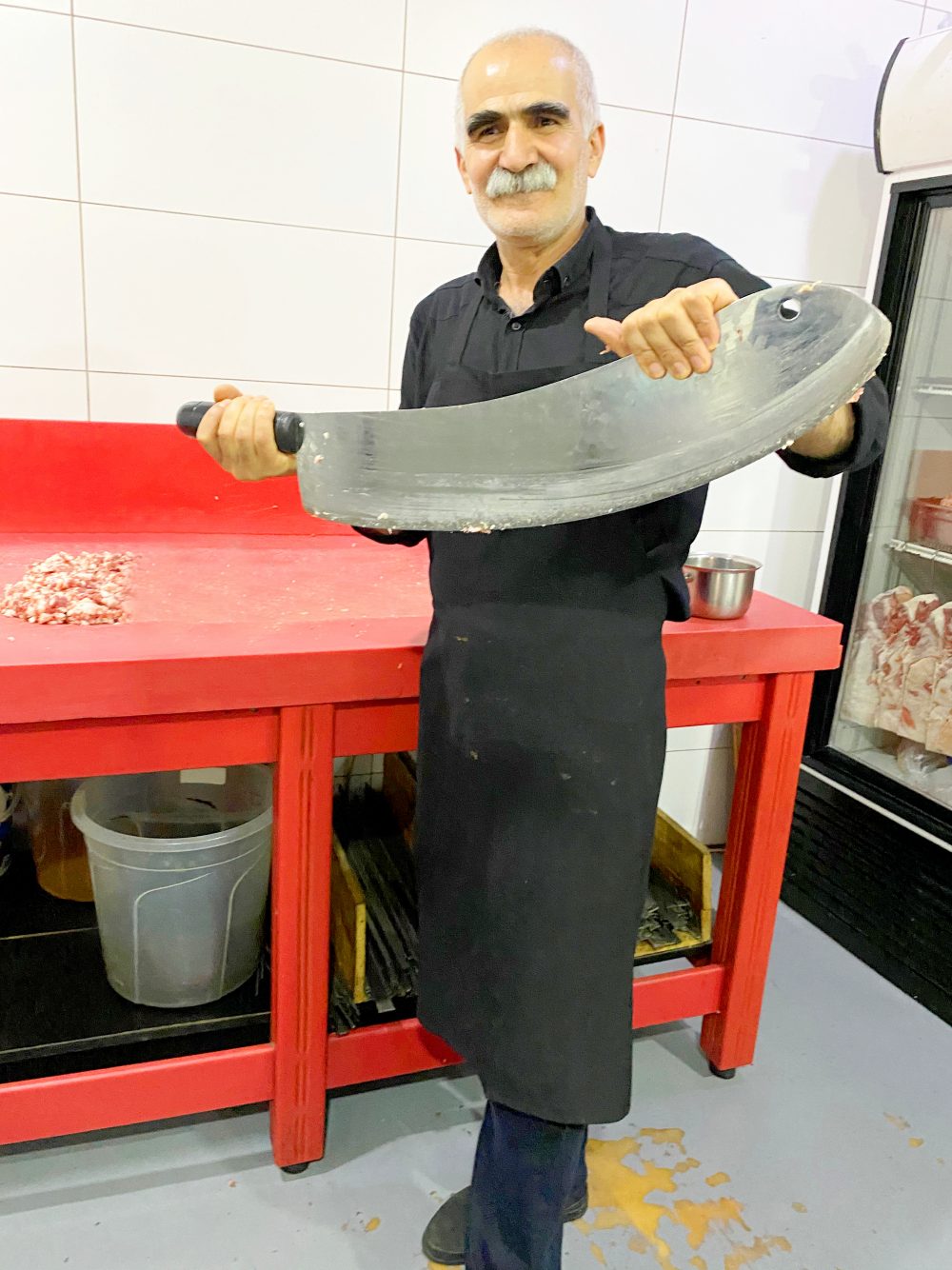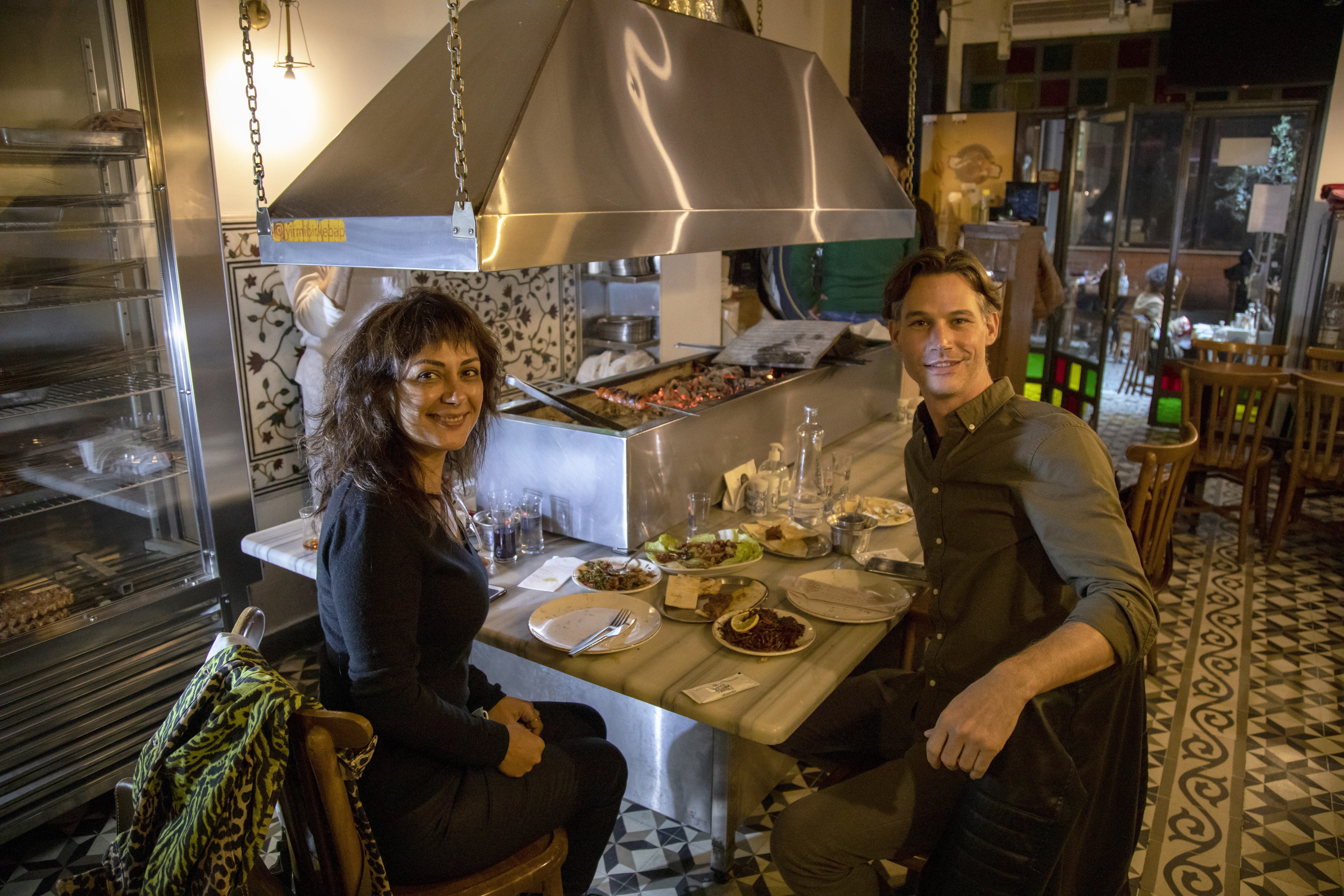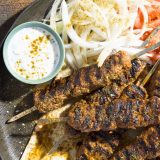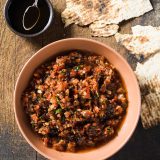Musa İnatçı stands barely 5 feet tall, but judging by the saber he’s holding that is half his size, I’m fairly certain he’ll beat me at arm-wrestling. Nevertheless, I accept his challenge, and we rest our elbows on a red chopping block next to a large mound of chopped lamb. He toys with me for a few seconds, then breezily puts me in my place, his sharp eyes framed by jet-black eyebrows and a bushy mustache.
Thankfully, that lesson in humility comes with more productive, tastier lessons. For one, what I considered a saber is actually a zirh, a massive, curved Turkish knife that translates to “shield” for its size. And it’s a critical tool for getting the proper texture of the luscious minced-meat kebabs that brought me to the upstairs kitchen of Yirmibir Ocakbaşı, a grill housed in a former Ottoman inn in Istanbul.
İnatçı grabs the zirh’s handle underhand on his right and stabilizes its blunt top with his left, then rhythmically rocks it through the mound of lamb to further break down the meat, averaging two chops per second. The zirh once weighed about 20 pounds, but after three years of constant sharpening, it’s worn down to 12. A 3-inch indentation in the chopping block offers further evidence of the oversized might packed into İnatçı’s arms.
It makes sense, since preparing the minced kebabs is his main task; there’s another butcher for other kebabs and cuts of meat, and a third chef dedicated to the small plates called meze.

İnatçı, whose family name means stubborn, has been chopping meat for 35 years. “If I wasn’t stubborn, I wouldn’t be doing this for so long,” he says.
Whole legs of lamb must be coarsely minced this way—into bits peasized or smaller, never ground smooth—so the kebabs retain the tender chew of detectable pieces of savory lamb. But it’s the binding that’s particularly unique, lacking any breadcrumbs or egg.
İnatçı wets his hands and kneads the chopped meat, then mixes in handfuls of minced kapya peppers, which resemble skinny red bell peppers but are sweeter and less bitter. Another key ingredient for the mixture is ghee, the clarified butter common to Indian cooking, which, depending on the fattiness of the lamb, could amount to as much as 10 percent of the finished mixture. Most minced kebabs also include oily chili flakes, the amount of which differentiates the two most common types, Adana and Urfa, named for the towns where they originated.
I will try both, but first İnatçı must form the seasoned lamb around flat metal skewers like elongated meatballs. He presses his fingers into the lamb to create a pattern of slanted ridges on one side, but palms the other side to keep it flat—a design he calls his signature style. The Adana have a distinctive red hue from all the chili flakes, while the Urfa are a few shades paler.
“In the kebab world, spiciness is crucial, and there’s a rivalry between Urfa and Adana all the time,” says my guide, Elizabet Kurumlu. “Adana is the spicier one, but they always argue about which one is better.”

We head to the ground floor dining room that once held the animals of caravans bringing goods from the East. The centerpiece of the room is a huge, rectangular charcoal grill, called an ocak (pronounced oh-JAHK), and we sit around it at a marble counter. The grillmaster behind it, Tevfik Tanriverdi, already has skewers loaded with lamb chops sizzling above glowing wood charcoal.
The counter fills with meze, small plates that, much as in neighboring Greece, can be finger foods to sop up raki during a night out drinking, but just as often are the opening act to grilled fish or meat. Grilled garlic cloves and onions tossed in olive oil and pomegranate molasses. A salad of tangy preserved za’atar, the wild oregano that forms part of a Middle Eastern spice mix. And silky hummus, which isn’t typically Turkish but was brought to the menu by a newer Syrian cook, scooped up with crispy lavash that’s pulled so thin you could almost read through it.
One highlight in particular from our lavish spread is the ezme, a dip-like salad of raw vegetables. There are numerous versions of this meze, but a classic variation combines raw onion, tomato, spicy green peppers and parsley—all finely chopped with a zirh. Sweet paprika lends color, while pomegranate molasses adds a hint of tartness to a simple mixture that’s fresh and bright, with distinct bits of each vegetable.
Sparks pop out of the grill onto the counter as Tanriverdi tends to a variety of sizzling meats— skewers of chicken wings, chunks of yogurt-marinated lamb, crispy-creamy liver coated in cumin, parsley, sumac and onion powder. Everything is shared, plates are passed around and raki refilled. It’s this communal nature that makes the ocakbaşı so appealing, says Tanriverdi, who points out sketches decorating the walls that were gifts from customers. “You can come here alone and talk to the person next to you and make new friends,” he says. “It’s like an American bar, but this is the Turkish style.”
Finally, it’s time for our kebabs, leaving the more fiery Adana second—since eating them the other way around would overwhelm the flavors of the milder Urfa skewers. The coals flare up as Tanriverdi places them on the grill, their juices dripping, enticing with the aromas of sizzling meat and fat. Each side is seared for just about a minute over the blazing hot side of the grill, then they are finished on the cooler side. Within a few minutes the kebabs have charred crisp exteriors in spots, differing textures thanks to İnatçı’s signature, ridged style.
Tanriverdi uses a piece of lavash like an oven mitt to slide the kebabs off the skewers and sprinkles them with salt. The meaty Urfa have a slight sweetness from the kapya pepper and just a hint of spice. The Adana carry a more robust, but manageable heat. Both are unimaginably juicy from the ghee, both with a delicious, toothsome quality and crispy bits on the peaks of the ridges.
For a home cook-friendly version, calling for a 3-foot knife clearly would be a bridge too far. Instead, we got similarly delicious results by pulsing lamb or beef in a food processor, then mixing it with ghee, red bell pepper and Aleppo for heat. We tinkered with the amount of bell pepper to adjust for the water content (which differs from kapya). This helped keep the minced meat from falling off the skewers.
A little sweet paprika added color that allowed us to adjust the chili to taste without losing the essence of an Adana kebab. Even with store-bought ground meat, the unique flavor of the peppers subtly showed through for a faithful rendition of what we had in Istanbul, minus the arm-wrestling defeat.





